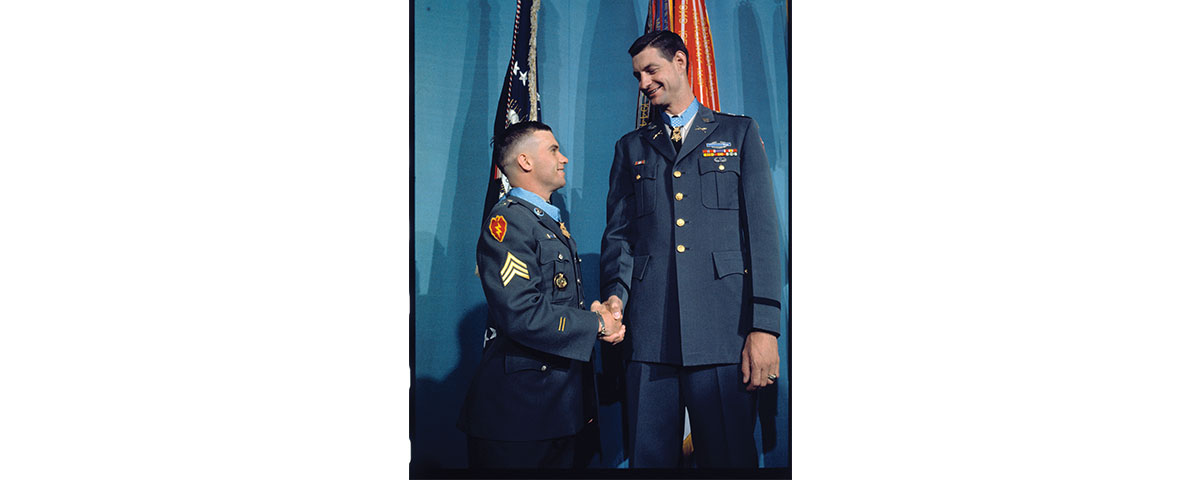Pfc. John Franklin Baker Jr. and Capt. Robert Franklin Foley both possessed uncommon valor
The 196th Light Infantry Brigade launched Operation Attleboro on Sept. 14, 1966, to conduct search-and-destroy missions against Viet Cong in Tay Ninh province, north of Saigon along the Cambodian border. By November the operation included elements of the 1st, 4th and 25th infantry divisions and the 173rd Airborne Brigade. On the morning of Nov. 3, troops of the 196th Light Infantry patrolled the dense forest 4 miles northwest of Dau Tieng base camp, home to a brigade of the 25th Infantry Division, including troops of the 27th Infantry Regiment, the “Wolfhounds.” Companies B and C of the Wolfhound regiment’s 1st Battalion were airlifted into blocking positions to assist the search-and-destroy units.
Immediately after Company C’s men left their helicopters, the Viet Cong attacked. The company’s commanding officer and first sergeant were killed. Maj. Guy S. Meloy III, the battalion commander, landed his helicopter under fire to take charge. By nightfall Company C had suffered heavy casualties.
The following morning reinforcements from various units moved toward Meloy’s position. By the morning of Nov. 5, companies of the 2nd Battalion, 27th Infantry, also had joined the fight, including Company A, commanded by Capt. Robert Franklin Foley, a 1963 West Point graduate and an imposing figure at 6 feet, 7 inches tall.
Assigned to relieve Viet Cong pressure on another unit, Foley’s company was only about 30 yards beyond friendly lines when it ran into a strong, concealed VC force. Snipers fired from trees, and enemy grenades fell like hail. Foley watched the initial ambush cut down several of his men.
“I was very angry with my soldiers getting killed,” he recalled, “so I grabbed a machine gun and ran into the offensive position.” Foley led two platoons against the VC, and when two radio operators were wounded he defied enemy fire to help them to relative safety.
Returning to action, Foley saw a machine gunner fall. Seizing the gun, he charged the VC emplacement as he shouted orders and directed his men. Foley was wounded and blown off his feet, but refused medical aid. While continuing to direct and inspire his men, he personally destroyed three enemy positions.
Not far from where the giant of an Army captain dominated the field of battle, Pfc. John Franklin Baker Jr., just 5 feet, 2 inches tall, also rose to the occasion. Strong and wiry, he had been inspired by his father’s work as a circus trapeze artist to build up his small frame.
When the Viet Cong attack began, Baker rushed to the head of his column and with a comrade knocked out two enemy bunkers before his friend was killed. He spotted four VC snipers and killed them, then withdrew with the other soldier’s body.
Baker advanced on two more bunkers and was wounded—but still managed to single-handedly destroy one of them. When a wounded comrade fell nearby, he grabbed the man’s machine gun and charged through heavy fire to destroy the other bunker. After Foley ordered the company to withdraw, Baker evacuated his comrade and returned to drag two more wounded men to the rear.
The actions of Foley’s company helped relieve the VC pressure on other embattled troops, and additional reinforcements arrived. When the 72-hour battle was over, 36 Wolfhounds had been killed. Meloy was awarded the Distinguished Service Cross for his heroic leadership.
On June 21, 1968, President Lyndon B. Johnson looked at the two men he had summoned to the White House and, noting the vast difference in height, made a joking reference to “Mutt and Jeff.” Then the 6-foot, 4-inch president bent down to hang the Medal of Honor around Baker’s neck and stood on his tiptoes to bestow the honor on Foley. The tallest and shortest of the then-living Medal of Honor recipients had earned their awards in the same unit on the same day. Despite the physical differences, they had an important characteristic in common—uncommon valor.
—Doug Sterner, an Army veteran who served two tours in Vietnam, is curator of the Military Times Hall of Valor, the largest database of U.S. military valor awards.
This article was published in the February 2019 issue of Vietnam.





